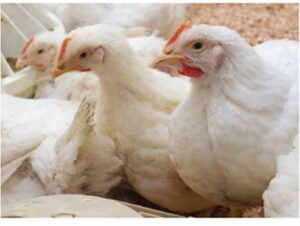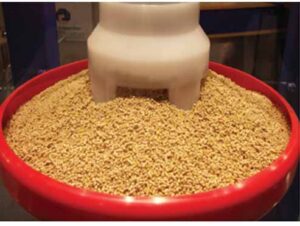Stewart Blair, Senior Manager Business Development, Cobb Europe

Feed conversion ratio (FCR) is a straightforward measure of how a bird converts its intake of feed to live weight. In this article, ‘economic feed conversion’ will be discussed, which is the ratio of feed amount used to produce a quantity of saleable liveweight. With economic FCR, feed wastage and mortality both impact the ratio.
Given that feed represents 60 to 70 % of the total cost of broiler production, FCR is understandably a key production indicator (KPI) which attracts great focus from farmers and integrations. With many producers placing great emphasis on achievement of best in class FCR, it is easy to lose sight of the ultimate economic goal which is to produce broiler liveweight at the lowest cost per kilogram (providing that it is produced on time and to specification). This means that it is vital to understand the economic impact of both feed cost and FCR in terms of feed cost per kilogram of liveweight produced, rather than viewing FCR as a standalone KPI.
How FCR will impact production and how it can be leveraged for full economic advantage (in terms of feed cost per kilogram liveweight) greatly depends on management, feed supply and feed cost. Many integrations have a reasonable degree of influence on their broiler growing activities but also on feed cost as a result of raw material buying power and adjusting costs through substitutions or watching commodity futures. On the other hand, independent farmers sourcing their feed from a local, third party mill may have little choice over feed cost and must focus on management. Refining management to ensure feed intake is high and wastage low will reduce the cost per kilogram of liveweight.
Small Changes in FCR at a Given Feed Cost
To break down how FCR impacts feed cost per kilogram of lightweight, consider how much each ‘point’ (0.01) of FCR costs at a given feed price using the formula.
For example, if an operation is currently achieving 1.550 FCR with a fixed feed cost of $350 per tonne and changes in management can improve FCR by just one point to 1.540, this would save 0.35 cents per kilogram liveweight. The impact of such a change is economically significant considering that 1 million birds harvested at 2 kg liveweight decreases cost / saves $7,000.
Analysis of the financial impact of each unit of FCR reveals that, in a scenario of elevated feed costs, each FCR unit carries a higher price. Consequently, any enhancement in FCR results in a more substantial return on investment. On the other hand, in a scenario of lower feed costs, each FCR unit becomes less costly, and improvements yield a lower return. This underscores the crucial role of feed cost in determining the financial viability of FCR improvements.
The above example only considers the impact of changes in FCR at a given feed cost. However, businesses can generate significant savings from small changes in feed cost. Keep in mind, there is a crossover point where reduction of diet cost will be so detrimental to FCR that feed cost per kilogram live weight will be the same or worse despite the lower feed cost per tonne.


Reduced Feed Cost and FCR:
Producers are often cautious around changing feed specifications and thereby cost as it is expected that a reduced feed cost will be so detrimental to FCR that it will offset any savings on feed cost per kilogram of liveweight. To determine the trade-off between feed cost and FCR, first accurately calculate how many points of feed conversion can be sacrificed whilst still making an overall saving, i.e. the safe zone in which FCR can drift before break-even is reached using the formula.
Example:
- Current feed cost of $330 per tonne
- Current FCR 1.550
- Proposed saving of $10 per tonne of feed (making feed $320 per tonne)
If feed cost was to be reduced from $330 to $320 per tonne, then feed efficiency could increase up to 4.8 points (from 1.550 to 1.598) before the feed cost saving is negated by increased consumption.
Additional Feed Cost and FCR
If it is possible to reduce feed cost and sacrifice a small amount of feed efficiency in order to decrease feed cost per kilogram of liveweight, then is it possible to increase feed cost, improve feed efficiency, and still reduce cost per kilogram of liveweight?
FCR and also ultimately decrease feed cost per kilogram of liveweight?
One method to improve the physical KPI of FCR is to employ a higher specification and thereby higher priced feed.
However there will also be a trade-off in terms of economic
gain. As with the reduction in feed cost, the required increase in feed efficiency needed to offset the additional expenditure can be calculated.
Example:
• Current feed cost of $320 per tonne
• Current FCR 1.560
• Proposed add of $5 per tonne of feed (making feed $325 per tonne)
If feed cost was increased from $320 to $325 per tonne then feed efficiency must immediately improve by at least 2.4 points (1.560 to 1.536) to compensate for the additional spend.
Conclusion:
No matter which part played in broiler production, whether it be as a farmer or a whole agricultural integration, the economic goal is to produce high quality broilers on time, to specification and at the lowest cost of production per kilogram of liveweight. The degree to which each stakeholder can influence cost of production varies greatly, but all have a level of control over feed cost per kilogram of liveweight through their management of feed cost, FCR or both
Improving FCR through management techniques or breed will always be an economically sound choice when feed costs are fixed. During the past 3 years, many producers have seen their feed costs fixed at historically high rates meaning that each small improvement in FCR gained has been relatively highly rewarded. That being said, ever better FCR should not be pursued to the detriment of the overarching KPI of feed cost per kilogram of liveweight.
When there is the option to reduce feed cost, it is a rapid route to reduced cost per kilogram of liveweight even if it comes with a small loss of feed efficiency. Although not the most satisfactory outcome to an FCR focused business, a poorer FCR in the context of low feed cost will not necessarily be economically damaging. Indeed, when planned correctly, a cheaper feed accompanied by a worsening FCR will at all times be economically better until break-even point is reached.
About this author;
Stewart Blair is currently Senior Manager, Business Development Cobb Europe where his team are responsible for product testing, trials and performance data from across EMEA. Stewart is a biologist with a PhD in Parasitology, who uses data from the field to inform how we can best act to ensure that animal production systems can achieve their full economic potential whilst maintaining world-leading welfare standards.